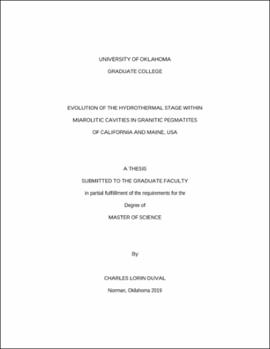| dc.description.abstract | Clay and alkali feldspar samples from miarolitic cavities of the pegmatites of Maine and California provide some of the best lines of evidence for gaining a better understanding of the hydrothermal stage within the pockets. X-ray diffraction (XRD) and energy dispersive x-ray analysis (EDXA) were used to analyze the mineralogy and chemistry of clay samples, and x-ray diffraction was used to determine the Al/Si order of the alkali feldspars. Clay samples are composed primarily of montmorillonite and kaolinite and in a few cases, illite, laumontite, and cookeite. A variety of other minerals is present within, including traces of primary pocket-forming minerals of quartz, albite, and microcline, in addition to oxides of goethite and todorokite. According to x-ray diffraction patterns from the International Centre for Diffraction Data (ICDD), three different patterns (Na0.3(Al,Mg)2Si4O10(OH)2·xH2O; (Ca,Na)0.3Al2(Si,Al)4O10(OH)2·xH2O; Ca0.2(Al,Mg)2Si4O10(OH)2 ·4H2O) best fit the montmorillonite minerals in the samples. The main distinction within these mineral varieties is the elements that occupy the interlayer and octahedral sites within the mineral. Energy dispersive x-ray analysis of the eight samples that are dominantly montmorillonite, showed some variation in magnesium and calcium values, 0.71-2.58 weight percent for magnesium and 1.48-2.14 weight percent for calcium. All samples showed essentially no presence of sodium. There were no clear correlations between the values from EDXA analyses and the varieties identified in the XRD patterns.
Alkali feldspar samples from miarolitic cavities yielded Al/Si order values in the range of 0.85 to 1.02, which were found to be indicative of recrystallization of the primary-formed feldspars. Alkali feldspars with high Al/Si order values indicate evidence of extensive recrystallization of the primary-formed feldspars within the miarolitic cavities and has been linked to a higher activity of H2O in the pegmatitic melt. With the presence of primary-formed minerals, zeolites, and clay minerals, evidence supports hydrothermal alteration of the aluminosilicate glass from the fluid exsolved from the pegmatitic melt and of later-stage hydrothermal alteration involving the host rock and primary minerals. The fluid begins as an alkaline-rich one and transitions to an acid-rich phase, precipitating zeolite minerals followed by smectite and finally kaolinite. | en_US |

